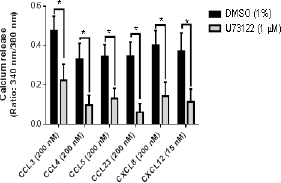Print version
Search Pub Med
| 032P Nottingham, UK 7th Focused Meeting on Cell Signalling |
Phospholipase C and Focal Adhesion Kinase are cell specific mediators of chemokine downstream signalling
Introduction: Chemokine receptors belong to the G-protein coupled receptor superfamily, and signal downstream through the dissociation of the heterotrimeric G-protein (Gαi/Gβγ subunits). Gαi can activate Steroid receptor coactivator1, a regulator of Focal adhesion kinase (FAK) and Phosphatidylinositol-4, 5-bisphosphate 3-kinase (PI3K)2, whilst Gβγ binds to Phospholipase C (PLC), a mediator for intracellular calcium release3. These signalling pathways control many cellular physiological changes, and their dysregulation is associated with cancer metastasis2, 3. Variations of these signalling pathways can arise depending on the chemokine ligand4 and cell type5. Our aim was to establish the importance of PLC, FAK and PI3K in the signalling pathways of different chemokines.
Method: MCF-7 (breast), PC-3 (prostate) and THP-1 (leukemic) cancer cell lines were incubated with small molecule inhibitors (30 mins), prior to chemokine stimulation. Intracellular calcium release was measured, by monitoring differences in fluorescence between the calcium bound (340 nm) and unbound (380 nm) Fura-2, before and after receptor activation. Compound cytotoxicity was assessed with an MTS assay. All data represents the mean±SEM, and was statistically analysed using one way ANOVA and an unpaired Student's t-test.

Figure 1. U73122 (1 μM) attenuates THP-1 intracellular calcium release in CCL3, CCL4, CCL5, CCL23, CXCL8 and CXCL12 signalling (*p≤0.05, n>4).
Results: PLC antagonist: U73122 (1 μM), significantly blocked CCL3 and CCL4 (200 nM) induced calcium release in MCF-7 (p≤0.05, n>5) and THP-1 cells (p≤0.05, n=6), and furthermore inhibited CCL5, CCL23, CXCL8 and CXCL12 signalling in THP-1 cells (Figure 1). In PC-3 cells, U73122 did not affect CCL3 and CXCL12 downstream signalling. Targeting FAK with FAK14 (1 μM), reduced CXCL12 associated calcium release, in THP-1 cells only (p≤0.05, n=3). None of the compounds demonstrated significant cytotoxicity in THP-1 or MCF-7 cells, after 30 mins incubation.
Conclusion: PLC is important in the downstream chemokine signalling of THP-1 cells, whilst in MCF- 7 cells, PLC was specific for CCL3 and CCL4. FAKs involvement in CXCL12 signalling, was dependent not only on the cell type, but also inhibitor, suggesting that within THP-1 cells, FAKs role may be independent of its kinase activity.
References:
1. Ma, YC et al. (2000). Cell 102: 635-646.
2. Bolós, V et al. (2010). Onco Targets Ther 3: 83.
3. Khan, SM et al. (2013). Pharmacol. Rev 65: 545-577.
4. Kerr, JS et al. (2013). Cell. Signal 25: 729-735.
5. Mills, SC et al. (2016). Cell. Signal 28: 316-324.

